
Systems of Equations With More Than Two Variables
 المؤلف:
المرجع الالكتروني للمعلوماتيه
المؤلف:
المرجع الالكتروني للمعلوماتيه
 المصدر:
www.almerja.com
المصدر:
www.almerja.com
 الجزء والصفحة:
...
الجزء والصفحة:
...
 9-3-2017
9-3-2017
 2084
2084
To solve any system of linear equations, you will need to have at least the same amount of equations as the amount of variables. This can then be done via the algebraic method or the algebraic elimination method. You can apply either method enough times to reduce each relation from a system of three or more equations with 3 or more variables to a system of 2 equations and two variables.
Sample: Solve for x, y and z.
2x - y + 6z = 1 (equation 1)
x - y + z = 2 (equation 2)
x + y + z = 1 (equation 3)
Steps:
1) Solve equation 1 for y.
After applying algebra, equation 1 becomes y = 2x + 6z - 1.
2) Plug the value of y or (2x + 6z -1) into equations 2 and 3.
Equation 2:
x - y + z = 2
x -(2x + 6z -1) + z = 2
x -2x - 6z + 1 = 2
-x - 6z = 2-1
-x -6z = 1
Equation 3:
x + y + z = 1
x + 2x + 6z -1 + z = 1
3x + 7z -1 = 1
3x + 7z = -1+1
3x + 7z = 0
We now have come down to a system of two equations and two variables.
Here are the two equations and two variables:
-x - 6z = 1 (equation A)
3x + 7z = 0 (equation B)
3) Solve equation A for x.
-x - 6z = 1
-x = 6z + 1
x = -6z - 1
4) Plug the value for x into equation B to solve for z.
3x + 7z = 0
3(-6z - 1) + 7z = 0
-18z - 3 + 7z = 0
-11z - 3 = 0
-11z = 3
z = - 11/3
5) Now plug the value for z into equation A to find x.
-x - 6z = 1
-x -6(-11/3) = 1
-x + 22 = 1
-x = -22 + 1
-x = -21
x = 21
Lastly or step 6, go back to ANY of the original 3 equations to find the value of y by substituting what you found for x and z. I will select equation 3.
Equation 3:
x + y + z = 1
21 + y -11/3 = 1
52/3 + y = 1
y = -52/3 + 1
y = -49/3
Final answer: x = 21, y = -49/3 and z = -11/3
There are cases when NO solution to a system is possible. The solution to a system takes place where the graph will cross or meet. In light of this, we can say that parallel lines (which have equal slopes) have NO solution because parallel lines never cross, touch or meet.
These two lines never meet, and thus have no intersection:

It is also possible to face a question where BOTH equations share the SAME LINE on the xy-plane. For example, 2r -s = 5 and 4r - 2s = 10 can be reduced to s = 2r - 5. Here, x = r and y = s. These two equations share the SAME LINE on the xy-plane.
In conclusion, ANY point that satisfies the equation s = 2r - 5 is a solution to this system.


 الاكثر قراءة في مواضيع عامة في الجبر
الاكثر قراءة في مواضيع عامة في الجبر
 اخر الاخبار
اخر الاخبار
اخبار العتبة العباسية المقدسة


